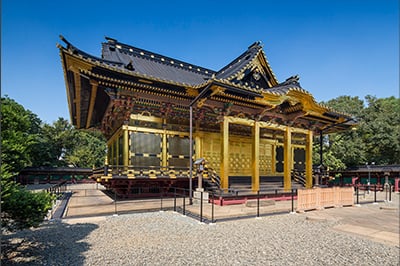The Spirit of Ieyasu Rests… Ueno Toshogu Ueno is a shrine dedicated to Tokugawa Ieyasu, the first shogun of the Edo period, located in Ueno Park in Tokyo, Japan. It is a grand and imposing structure, built in 1617 and completely renovated in 1651, that is considered one of the finest examples of Edo period architecture.
History of Ueno Toshogu
The history of Ueno Toshogu is an incredibly rich and storied one. It began in 1616 when Tokugawa Ieyasu, the first shogun of the Tokugawa shogunate, ordered the construction of the shrine complex in Ueno Park to commemorate his death. Ueno Toshogu was completed in 1651, and has been a major cultural and religious landmark in Tokyo ever since. The shrine is dedicated to Ieyasu and is considered a symbol of his spirit, which is why it is known as the “Spirit of Ieyasu Rests.”
Ueno Toshogu is also a National Treasure of Japan and contains many stunning, intricate details. The complex consists of five buildings: the main sanctuary, the main hall, the inner sanctuary, the inner hall, and the Noh stage. The shrine is also home to a number of cultural artifacts, including a bronze Buddha, a five-story pagoda, and a variety of sculptures and carvings.
The shrine is a popular tourist destination and is well-known for its beautiful gardens and tranquil atmosphere. Visitors can take part in traditional Shinto ceremonies and festivals, as well as explore the shrine’s many artworks and artifacts. Ueno Toshogu is also a popular spot for cherry blossom viewing in the spring. The shrine is a perfect place to explore Tokyo’s history and culture, and to appreciate the importance of Ieyasu and his legacy.
Significance of Ieyasu Tokugawa
The Spirit of Ieyasu Tokugawa rests at Ueno Toshogu in Ueno, Japan. Ieyasu Tokugawa is an influential figure in Japanese history and is remembered as the founder of the Tokugawa Shogunate, a dynasty that ruled Japan for over two-and-a-half centuries. Ieyasu’s legacy is still evident today, both in his physical remains at Ueno Toshogu, and in the cultural and social influence his rule had on Japan.
Ieyasu was a powerful leader and a great military strategist, who was able to unify the country and secure peace after a period of prolonged civil war. He established a centralized government system which brought administrative, political and cultural unity to Japan and allowed for a period of prosperous growth. Ieyasu was also a proponent of Neo-Confucianism, a Chinese philosophy which became the guiding force of the Tokugawa period, and was instrumental in introducing a range of cultural and religious practices, including the veneration of Shinto shrines and the practice of ancestor worship.
Ieyasu is remembered as a great leader and a symbol of unity, and Ueno Toshogu is a testament to his legacy. The shrine was built in 1627 as a memorial to Ieyasu and contains his remains. It is a popular tourist attraction and is home to a number of cultural and religious artifacts associated with the Tokugawa period. It is also a site of pilgrimage for many people, who come to pay their respects and to remember Ieyasu’s legacy.
Ueno Toshogu is a symbol of the significance of Ieyasu Tokugawa and his lasting impact on Japan. His legacy was one of unity and prosperity, and the shrine serves as a reminder of the importance of his rule and his dedication to the unification of Japan.
Architecture and Art of Ueno Toshogu
Ueno Toshogu is a shrine dedicated to the spirit of Ieyasu Tokugawa, the founder of the Tokugawa shogunate. Located in Ueno Park, Tokyo, the shrine is a testament to the artistic beauty of the Edo period. The shrine was built in 1651 and contains many works of art from the period. Notable pieces include the “Hikone-zukuri” style of architecture, the three-dimensional sculptures of the gods of the shrine, and the numerous carvings of dragons and other symbolic animals. The shrine also features a number of paintings and lacquerware, both of which were popular during the Edo period.
Ueno Toshogu is a unique representation of the Edo period and its artistry. The shrine is a must-see for anyone interested in learning more about the culture and art of the era. Its architecture and art are a reflection of the spirit of Ieyasu Tokugawa, and visitors can feel a connection to his spirit as they marvel at the intricate details and craftsmanship of the shrine.
Cultural Relevance of Ueno Toshogu
Ueno Toshogu is a striking structure that stands out in the vast expanse of Tokyo’s Ueno Park. It is a mausoleum dedicated to Tokugawa Ieyasu, the first Shogun of the Edo period. Built in 1617, it is considered a masterpiece of Japanese architecture, and is a highly important cultural symbol of Japan. The architecture of the structure, which features several ornate carvings, gold leaf, and beautiful paintings, reflects the high status of Ieyasu in the Edo period, and is a testament to the power and cultural sophistication of the period.
The grounds of the shrine are also home to numerous other structures, including a five-story pagoda, several gates, and a variety of smaller shrines. The grounds are a popular destination for tourists and locals alike, who come to pay respects to Ieyasu and to enjoy the beauty of the shrine. Ueno Toshogu is a powerful reminder of the cultural legacy of the Edo period and serves as an important symbol of Japanese identity.
Conclusion
The Spirit of Ieyasu Tokugawa, the first Shogun of the Edo period, who unified Japan, still rests proudly in Ueno Toshogu. This majestic shrine is a testament to both the power and beauty of the Edo period. From its intricate carvings to its spectacular architecture, Ueno Toshogu is a must-see destination for anyone interested in Japanese history. The grandeur of Ieyasu’s spirit still stands tall in Ueno Toshogu, a reminder of both the power and beauty of the Edo period. With its rich history, stunning architecture, and a beautiful setting, Ueno Toshogu is an unforgettable experience that no visitor to Japan should miss.


